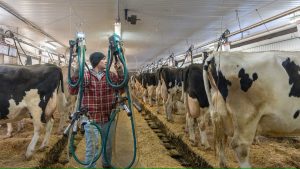
Today’s historically high inflation presents us with a rare opportunity to achieve a permanent reduction in Canadians’ cost of living.
We can do that by finally scrapping an archaic practice that has been in ill repute for generations.
Yes, we are talking about the accursed supply management system in agriculture, and notably in the $23-billion dairy industry.
It has long forced consumers to pay artificially high prices for essential food.
The beneficial impact of that significant reform stands in contrast to recent temporary and largely ineffectual inflation fixes like gas-tax holidays.
Gas-tax holidays have been adopted in Ontario and most G7 countries except Canada. But they simply encourage more of the gasoline consumption that is a principal cause of today’s decades-high inflation.
And the Conservative party of Canada’s call for costly government job-creation programs is tough to figure with the country already at full employment. The current overabundance of jobs with no one to fill them is already a major cause of inflation.
At least those ideas make more sense than Tory leadership candidate Pierre Poilievre’s moronic but, in some quarters, popular notion of replacing Canadian currency with notoriously volatile cryptocurrencies so that Canadians can “opt out of inflation.”
News flash: Bitcoin has lost more than 70 per cent of its value since its March peak, and bankruptcies of crypto lenders are piling up. Poilievre’s scheme would amount to betting the entire economy on Uncle Pete’s Moustache in the eighth, the only horse in the race with training wheels (Apologies to Woody Allen.)
There is cause to deploy highly targeted forms of inflation relief for low-income Canadian households and people whose livelihoods most expose them to rising costs of essential goods.
Immediate cash infusions into the country’s overstressed food banks among the few appropriate quick remedies for widespread inflation pain.
But in this moment of unusual inflationary hardship for Canadians, there is potential to summon the popular and political will to put an end to supply management in agriculture.
That system is currently compounding our suffering from inflation. And the artificially high costs it inflicts on Canadian consumers will continue long after our inflation nightmare is over.
The supply management system in dairy tells farmers what they can produce and how much. In turn, it guarantees an artificial, quasi-state imposed minimum price for their goods.
In doing so, the system also prevents competition, especially from offshore providers. That leaves us at the mercy of a domestic cartel, whose members are more affluent than everyday Canadians.
That, of course, violates Canada’s self-image as a free trader, a rebuke to our own hard-won free-trade alliances.
But on dairy, Ottawa is intransigent in shielding farmers from competition with our international trading partners.
That has Canada mired in trade disputes over our rigged dairy-price system with the U.S., Britain, and New Zealand. This undermines our credibility as a country that promotes the rules of international law — except in food.
Admittedly, every country enlightened about free trade still tries to protect its farmers. But the Canadian system goes overboard, and its chief victim is Canadian consumers.
An unofficial joint venture of the Canadian Dairy Commission, a federal Crown corporation; provincial marketing boards; and the powerful farmer lobbies sets prices above where they would be if genuine competition existed.
And the system’s production quotas discourage Canadian farmers from increasing production, improving efficiency, and developing high-quality and specialized products for domestic and world markets.
When New Zealand and Australia, to pick two examples, abandoned their supply management practices, the result was higher production, lower consumer prices, a surge in export revenues, and a tax boost for government treasuries.
We can do better.
When Canada was forced by international law to stop subsidizing its protected wine industry, Canadian vintners spent the 1990s reinventing themselves as makers of lucrative, high-quality products that win awards worldwide.
The urgency here should be obvious.
Canadian food-price inflation is outpacing the general rate of price increases.
In April, food inflation was 9.7 per cent against the national inflation rate of 6.8 per cent. In that month, the prices of supply-managed products soared for butter (up 15.2 per cent), milk (7.9), and cheese (7.2).
The pattern continued in May, the latest month for which we have figures, with food inflation of 9.7 per cent against general inflation of 7.7 per cent.
Pre-pandemic research on the negative impact of supply management in agriculture showed that the average Canadian household pays an extra $300 to $444 a year on basic food.
The current system is socially unacceptable.
The brunt of those permanently inflated prices for agricultural goods falls on low-income Canadians, who spend almost 20 per cent of their incomes on food. That compares with 7.8 per cent for middle-income and 4.1 per cent for upper-income earners.
Imagine a serving of world-class free-market priced Canadian milk, cheese or yogurt on a summer day.
Now that would be refreshing.

























